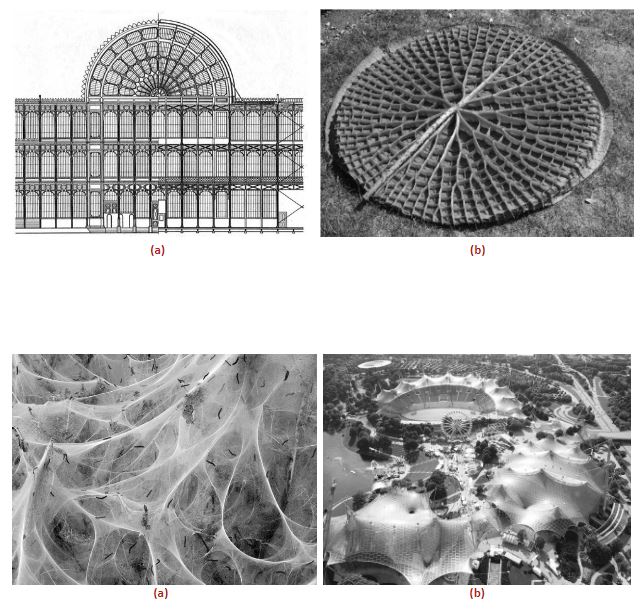Biomimetic in Lightweight Structures: Solution for Sustainable Design
Keywords:
biomimetic, bionic, sustainable, lightweight structuresAbstract
Most of structures developed by human get inspiration from nature. Designers have often taken inspiration from nature not only for forms and aesthetics but also taken solutions to solve the design problems, called ‘biomimetic approach’, which could be either problem-based (from design to nature), or solution-based (from nature to design). Biomimetic relates closely with lightweight design because both of them based on natural principles: saving energy and recycling waste. The lightweight structure, in term of a material-efficient, is considered as an energy-saving and cost-effective design because the materials strengths are optimally used, then no resources are waste. The main aim of this article is to review the applications of biomimetic approaches in architecture and lightweight structure as a potential solution to sustainable design. Several case studies present various levels of applications and show how biomimetic inspiration can contribute to achieve more sustainable building design.
Downloads
References
Arbabzadeh, M., Etesam, I., & Mofidi, S.M. (2017). Biomimetic and Vernacular Building Design in Connection with Environment. Eurasian J Biosci 11, 37-44.
Asefi, M., & Afzali, Z. (2016). Environmentally Sustainable Architecture: Material-based Technological Design Approach. Current World Environment, 11(1), 28.
Baird, G. (2001). The Architecture Expression of Environment Control Systems. London and New York, Spon Press.
Bartol, I. K., Gordon, M. S., Webb, P., Weihs, D., & Gharib, M. (2008). Evidence of Self-correcting Spiral Flows in Swimming Boxfishes. Bioinspiration & Biomimetics, 3 (1), 14001.
Benyus, J. (1997). Biomimicry: Innovation Inspired by Nature. New York. Harper Collins Publishers.
Dierks, K., & Wormuth, R. (2012). Baukonstruktion. Werner Verlag, München.
Fuller, R. B. (1975). Synergetics: Explorations in the Geometry of Thinking. MacMillan, New York.
Gruber, P. (2011). Biomimetics in Architecture: Architectureof Life and Buildings. Springer-Verlag/Wien, Germany.
Kim, J., & Park, K. (2018). The Design Characteristics of Nature-inspired Buildings. Civil Engineering and Architecture, 6(2), 88-107.
Lakhtakia, A., & Martin-Palma, R.J. (2013). Engineered Biomimicry, Elsevier Inc., Waltham, MA, USA.
Luchsinger, R.H., Pedretti, M, & Reinhard, A.J. (2004). Pressure Induced Stability: From Pneumatic Structures to Tensairity. Journal of Bionic Engineering, 1:141.
Mazzoleni, I. (2013). Architecture follows Nature. CRC Press, California, USA.
Mohamed, A. S. Y. (2018). Biometic Architecture: Creating a Passive Defense System in Building Skin to Solve Zero Carbon Construction Dilemma. Environmental Quality (EQA), 29, pp.1-28.
Park, K. G., Lee, D. W, & Kwun, T.J. (2016). Mechanical Characteristics of Large Span Spoke Wheel System. Proceedings of International Association for Spatial Structures (IASS), D1341.
Pohl, G. (2006). Faszination Bionik: Die Intelligenz der Schöpfung. In:K.G. Blüchel, F. Malik, SWR, & Das Erste, Verlag Bionik Media GmbH.
Schmitt, O. (1969). Some Interesting and Useful Biomimetic Transforms. In Proceedings of Third Int. Biophysics Congress.
Zari, M. P. (2007). Biomimetic Approaches to Architectural Design for Increased Sustainability. Auckland, New Zealand.
Zari, M. P. (2018). Regenerative Urban Design and Ecosystem Biomimicry. Routledge,New York.

Downloads
Published
How to Cite
Issue
Section
License
Copyright (c) 2019 International Journal of Building, Urban, Interior and Landscape Technology (BUILT)

This work is licensed under a Creative Commons Attribution-NonCommercial-NoDerivatives 4.0 International License.











